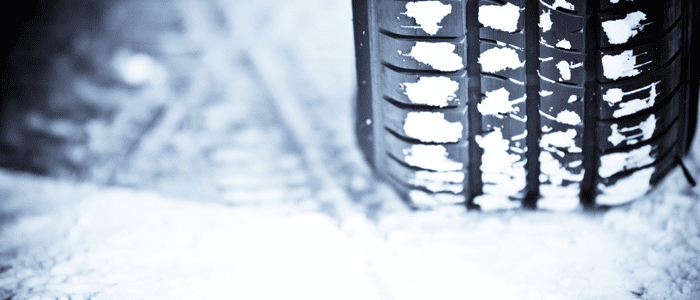Three key tips for safer winter driving

3 minute read
If you or your staff drive for a living during Canadian winters, icy roads, blowing snow, and even highway closures can be detrimental to your business and your employees’ safety. Here are three key tips on how you can help keep your company’s driving record clean despite these conditions:
1. Preventative maintenance
Preventative maintenance for your car is essential in the winter. Here are six things you should check in your company car before someone gets behind the wheel:
Winter tires
It’s important that you switch out your regular tires for winter tires, as there’s a clear difference in performance between winter tires and all-season tires. The special rubber compound in winter tires allows them to stay flexible and grip snow and ice for optimum traction.
You should also check the air pressure in all four tires and your spare tire. In the winter, the pressure in tires tends to drop significantly due to the cold air, so routine checks throughout the winter months are a good idea.
Batteries
Battery faults can cause breakdowns, especially during the winter when the drop in temperature can take a particularly high toll on a battery’s life. Generally, the average battery life is three to five years. So, if you’ve had your battery for more than five years and you’re experiencing difficulties with starting your car, you may want to consider getting a new battery.
Vehicle fluids
Any time before driving this winter, make sure your gas tank is full in case of a traffic jam or bad weather conditions that force you to pull over and idle for some time. If you haven’t changed the engine oil in your car in a while, it’s also a good idea to do that.
Ensure you always have a sufficient amount of windshield washer fluid and replace engine coolants after more than two years.
Wiper blades
Wiper blades are an important tool for winter driving, as they help ensure that you can always see the road ahead of you. It’s important to check your wiper blades early in the season and replace blades if they streak.
Brakes
The last thing anyone wants is to find out their brakes don’t work at the most inopportune moment. This is especially true in the winter when there’s a higher chance of ice on the road. That’s why it’s important to service your brakes to ensure they’re in proper working order.
Lighting
It’s important to make sure your car’s lights are in good shape and can easily illuminate your drive, as it is darker a lot earlier in the winter months. Make sure to fix any bulbs that are out and consider replacing any headlights that are foggy or yellow. Also remember to clear away any snow covering exterior lights before you set out on the road.
2. Institute a Driver Policy
If you have employees that drive for your business, it is especially important that you put policies and procedures in place to promote responsible driving. A safe winter driving policy is a formal document that defines how your staff should drive your company’s vehicles to keep themselves and others safe on the road. Having all your employees sign a Driver Policy reinforces the standards you expect them to follow when using company cars. It also reassures your drivers that they have your full support in case they get in an accident, so long as they’re driving safely.
3. Check your emergency roadside safety kit
Hazardous conditions often lead to road closures and long delays in help arriving at the scene of an accident. So make sure each of your cars has a stocked emergency roadside safety kit which includes:
The basics
Your company’s emergency kit can be as extensive or as basic as you’d like, but there are a few essentials that you should consider including in every single kit, such as:
A shovel
Tow rope or chain
Booster cables
Fuel line antifreeze
A small tool kit
A fire extinguisher
To alert rescuers
It doesn’t hurt to have the necessary equipment to help ensure you get help when you need it. In order to do this, you should pack the following items:
Road flares or warning lights
Bright cloth to use as a flag
‘Call Police’ sign
Flashlight and extra batteries
If you’re trapped in a snowstorm
During the colder months, it’s even more dangerous to be stranded in your car. Having these key items in your kit could help keep you warm and well fed while you wait for help:
Emergency food (non-perishable such as canned fruit, nuts, candy, biscuits, crackers, cookies, dried beef, honey)
Extra clothing and footwear
Blankets
Matches
Bottled water
A candle and small tin
Can opener and pocket knife
First aid kit
Some listed items may not help prevent incidents, but they can still stop delays from becoming disasters, or small accidents from becoming emergencies.
Protect yourself and your business
While you can make every effort to avoid an emergency, sometimes things can still go wrong. That’s why it’s important to be as prepared as possible. For more ways to protect yourself and your business, visit our commercial auto insurance page today!
This blog is provided for information only and is not a substitute for professional advice. We make no representations or warranties regarding the accuracy or completeness of the information and will not be responsible for any loss arising out of reliance on the information.






